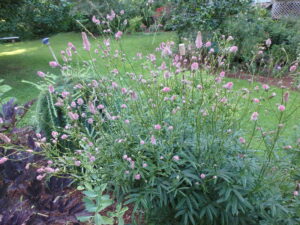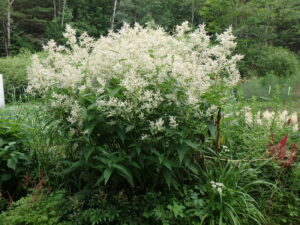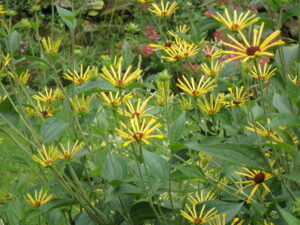Perennial Flowers That Like Moist Places
This year I have some new plants in my primrose garden given to me by a new friend and fellow garden writer, Judith Irven of Goshen,Vermont (https://
I have at least 4 other kinds of burnet, starting with a little one with variegated green and white leaves and deep maroon flowers (Sanguisorba officinalis var. microcephala ‘Little Angel’). I have others that grow 2-feet tall, and one that is 4 feet tall, both probably varieties of S. officianalis. The taller ones I tie up with stakes and strings by mid-July to keep them from flopping. A single plant will grow to be a big clump, taking a space four feet wide.
I am still looking for a burnet called ‘Lilac Squirrel’, a variety of S. hakusenensis. The name, and blossoms that resemble pink boas, are too outrageous not to want one. If you have one, please email a photo. Like all burnets, it likes moist soil and sunshine, from what I have read. It is hardy to Zone 5 – minus 20 in winter.
Another interesting genus is Persicaria, the fleece flowers. I have two species, P. polymorha or giant fleece flower and red bistort or mountain fleece (S. amplexicaulis). Giant fleeceflower makes a clump 6 to 8-feet tall and wide, with white blossoms a bit like astillbe blossoms – on steroids. The stems are an inch wide or more, but hollow like Japanese knotweed. The nice thing about it is that the flowers look good even after they have gone by, so 2 months of beauty is a given. Moving one is hard work, so plant it where you have plenty of space for it.
I have mountain fleece under the apple trees in my primrose garden, and the red bottle-brush flowers are just coming into bloom on 3- to 4-foot stems. The leaves are large, pointy and heart-shaped. Like its cousin, the bloom time is long: from now through much of the fall.
There are plenty of wildflowers that do well in moist shade. Prime among them are Jack-in-the-pulpit, red baneberry, trillium, and ramps. I grew up in Connecticut where there was skunk cabbage growing by our stream, and I bought a small clump some 25 years ago at The Garden in the Woods in Framingham, Mass. What a difference a couple of hundred miles makes. This early-spring bloomer has only recently achieved full size! I attribute that to the climate.
Many plants that grow well in ordinary garden soil will thrive in moist soil, too. I have Black-Eyed Susans (Rudbeckia spp.) that love my moist, sunny gardens but would be equally at home in drier soil. My favorite is Henry Eiler, one that blooms late and has very distinctive blossoms with the petals unnaturally far apart.
If you want to grow a shade-loving plant in a sunny location, you will have a better chance of success if the soil is also moist. Even then, not all succeed. But if you have space, and a willingness to experiment, your flowers may surprise you.
Henry lives in Cornish Flat, NH. His e-mail is henry.homeyer@comcast.net.






